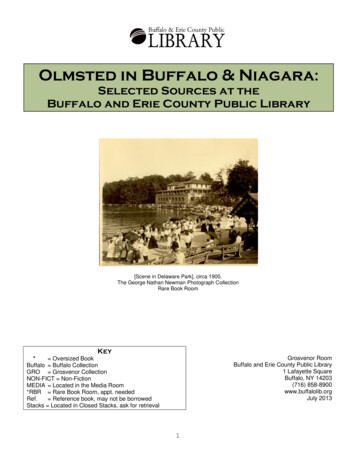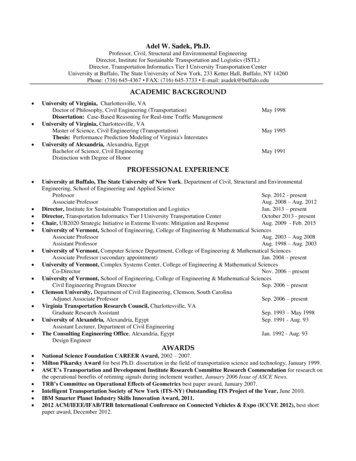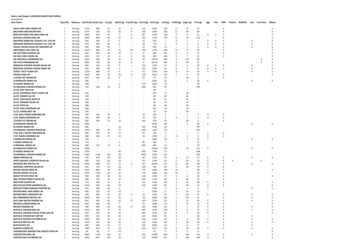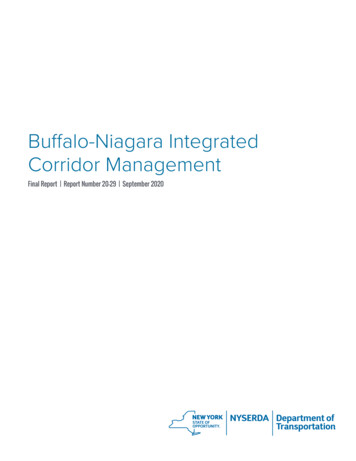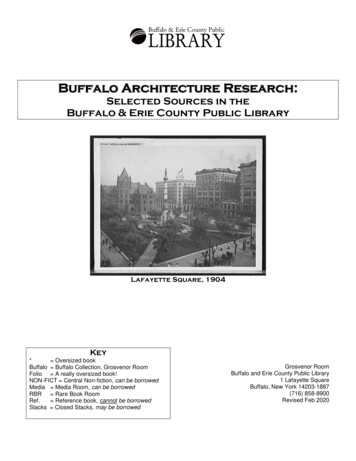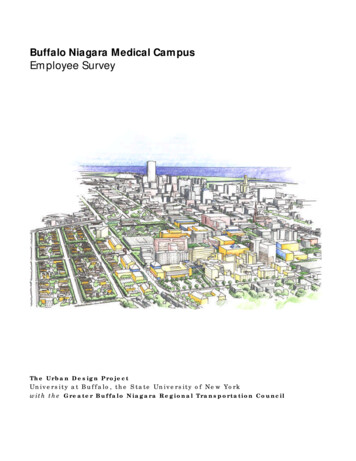
Transcription
GEOLOGICAL SURVEY CIRCULAR 173WATER RESOURCES OF THE BUFFALONIAGARA FALLS REGIONBy Charles W. Reck, and Edward T. Simmons
UNITEb STATES DEPARTMENT OF THE INTERIOROscar L. Chapman, SecretaryGEOLOGICAL SURVEYW. E. Wrather, DirectorGEOLOGICAL SURVEY CffiCULAR 173WATER RESOURCES OF THE BUFFALO-NIAGARA FALLS REGIONBy Charles W. Reck, and Edward T. SimmonsBased on data collected in cooperation with the New York Department of PublicWorks, New York Department of Conservation, New York Power and ControlCommission, and Corps. of EngineersWashington, D. C., 1952Free on application to the Geological Survey, Washington 25, D. C.
CONTENTSIntroduction . .The Niagara Frontier . .Topography . .Climate . .Population and industry . .Natural resources . : . .Sources of water . .Surface water . .Lake Erie: . .Lake Ontario . .Niagara River . .Buffalo Creek . .Cayuga Creek . .Cazenovia Creek . .Buffalo River . , . .Tonawanda Creek . .Other streams . .Ground water . .Water-bearing formations . .Yields of wells . .Page11112PageGround water-ContinuedQuality of water . .Pollution . .Temperature . .Public water supplies . .City of Buffalo . - . .City of Niagara Falls . .Western New York Water Co . .City of Lockport . .City of Tonawanda . .City of North Tonawanda . .Present water use . .Public supplies . .Industrial supplies . .Water power . .Navigation . .Water laws . .Potentialities . .Selected references . 8.9.10,11.12.13.14.15.16.17.18.19.20.21.22.PageMap showing water resources of Buffalo-Niagara region . Inside back coverMaximum and minimum daily and average monthly air temperature . .2Maximum, minimum, and mean monthly precipitation at Buffalo . .2Mean monthly snowfall at Buffalo . .2Yearly mean elevation of Lake Erie (elevation above mean tide at New York City) . .5Average seasonal temperature of Niagara River . .5Maximum, average, and minimum monthly and annual discharge Niagara River at Buffalo . .6Maximum, average, and minimum monthly and annual discharge Buffalo Creek at Gardenville .7Flow-duration curve for Buffalo Creek at Gardenville . .8Maximum period of deficient discharge Buffalo Creek at Gardenville.9Maximum, average, and minimum monthly and annual discharge Cayuga Creek nearLancaster.10Flow-duration curve for Cayuga Creek near Lancaster, N. Y.11Maximum period of deficient discharge for Cayuga Creek near Lancaster.12Maximum, average, and minimum monthly and annual discharge Cazenovia Creek atEbenezer.13Flow-duration curve for Cazenovia Creek at Ebenezer.14Maximum period of deficient discharge for Cazenovia Creek at Ebenezer.15Flow-duration curve for Tonawanda Creek between Batavia and Millersport.16Maximum period of deficient discharge for Tonawanda Creek between Batavia and Millersport.17Water level in observation well Ni 30 near Youngstown and daily precipitation at Lewiston,September 1950 to August 1951. . .18Yield of wells in the Niagara Frontier.20Effect of induced infiltration on chemical quality of ground water in the Lockport dolomite.22Effect of induced infiltration on temperature of ground water.23Estimated average daily industrial and municipal ground-water pumpage . -. .25TABLESTable1.2.3.4.5.6.7.Area and population of political subdivisions in the Niagara Frontier . .Chemical quality of surface water in the Niagara Frontier . .Drainage areas of small streams in the Buffalo-Niagara Falls region . .Summary of data on wells in the unconsolidated rocks . .Chemical quality of ground water in the Buffalo-Niagara Falls region . .Variation of the chemical quality of water from well (E1) . .Population served, average consumption and rated capacities of public water-supply systems .IIIPage371720212324
WATER RESOURCES OF THE BUFFALO-NIAGARA FALLS REGIONINTRODUCTIONAn average daily flow of 12 5, 000 million gal is available at the eastern end of Lake Erie where the NiagaraRiver drains the inland waters northward to Lake Ontario. This quantity is sufficient to supply 70 percentof the present estimated daily use of water in the UnitedStates for all purposes except water power. The temperature and chemical characteristics of this water aresuitable for most purposes. Moderate quantities of water may be obtained also from small streams and wellsin the area. With such large quantities of water of goodquality near at hand there should be no water shortagefor the million or more people in the Buffalo-NiagaraFalls area.The economic growth of an area depends upon a satisfactory supply of water. In order to assure successand economy, the development of water resourcesshould be based on a thorough knowledge of the quantityand quality of the water. As a nation, we can not afford to run the risk of dissipating our resources especially in times of national emergency, by buildingprojects that are not founded on sound engineeringknowledge.The purpose of this report is to summarize and interpret all available water-resources information ofthe Buffalo-Niagara Falls region. This report will beuseful for initial guidance in the location or expansionof water facilities for defense and nondefense industries and the municipalities upon which they are dependent. No attempt has been made to present a complete record of the hydrologic information.Most of the facts presented herein are based on dataobtained for other purposes by the U. S. GeologicalSurvey in cooperation with the New York State Department of Public Works, Department of Conservation,Water Power and Control Commission, and the Corpsof Engineers.Much information regarding conditions in the areawas obtained from the Erie County Department ofHealth, the Buffalo Sewer Authority, the NorthwesternNew York Water Authority, and the New York State Department of Health.This report was prepared in the Water ResourcesDivision of the· U. S. Geological Survey under the immediate supervision of Arthur W. Harrington, districtengineer, and Maurice L. Brashears, Jr., districtgeologist, and under the general direction of C. G.Paulsen, chief hydraulic engineer.The Niagara FrontierThe Buffalo-Niagara Falls region, locally called theNiagara Frontier, is defined as that area in Erie andNiagara Counties in New York bounded on the south byEighteenmile Creek; on the west by Lake Erie and theNiagara River; on the north by Lake Ontario; and onthe east by a line just east of the village of EastAurora and the city of Lockport (see pl. 1).TopographyThe topography of the Niagara Frontier is of a relatively simple type. Three plains comprise the region Erie, Huron, and Ontario - which form steps descending northward to Lake Ontario. The Erie and Huronplains are separated by the Onondaga escarpment, andthe Huron and Ontario plains by the Niagara escarpment (see pl. 1). The Niagara escarpment, which liesnorth of Niagara Falls, rises abruptly 200 ft above theOntario plain. The Ontario plain drains northward toLake Ontario and is nearly level in most areas. TheHuron plain lies about 600 ft above mean sea level.Although nearly level this plain dips southward to theOnondaga escarpment. In the vicinity of Buffalo, theOnondaga escarpment is less evident than at the easternboundary of the area where it rises about 70 ft above theHuron plain. The Portage escarpment, the southernboundary of the Erie plain, lies outside of the area under consideration. It is moderately steep in the vicinity of Cattaraugus Creek but to the northeast it becomesill-defined and broken by deep narrow valleys. Thesurface of the plains has been made uneven by the irregular deposition of rock material from glacial ice.After the retreat of the glacier, the lowland areas ofErie and Niagara Counties were covered by a lake.Lake bottom deposits of clay now determine the topographic features of the region.ClimateThe Niagara Frontier has a temperate climate andextremes in temperature are moderated by the proximity of Lake Erie and Lake Ontario. Lake Erie to
WATER RESOURCES OF THE BUFFALO-NIAGARA FALLS REGION2the southwest lies in the direction of the prevailingwinds. The U. S. Weather Bureau has maintained aweather station at Buffalo for 81 yr. The mean annualair temperature of 47. 1 F as recorded in Buffalo isrepresentative of the Niagara Frontier. The highestrecorded air temperature is 99 F and the lowest -21 F.Air temperatures above 90 F and below 0 F are rare.Figure 1 shows the maximum and minimum daily andmean monthly air temperatures at Buffalo for theperiod 1870 to 1950. The east end of Lake Erie, somequiet portions of the Niagara River, and Lake Ontarioalong its shore, freeze over during the winter. Theaverage recorded frost-free period is 140 days in theuplands and 170 days in the lowlands.Precipitation is moderate and usually evenly distributed throughout the year (fig. 2). It ranges fromabout 30 in. annually in the northern part of the areato 38 in. in the southern part and averages 34.85 in.at Buffalo. During the winter arctic air crossing thelake causes local heavy snowfalls. The area has amean annual snowfall of 6 ft, but has exceeded a totalof 10 ft twice since 1899. Snowfall in excess of 1 in.occurs on the average of 22 days each year. Meanmonthly snowfall at Buffalo for the period 1884 to 1950is shown in figure re 2. -Maximum, minimum, and mean monthlyprecipitation at Buffalo.Cheap hydroelectric power and good transportationfacilities in the Niagara Frontier have been amongthe prime factors in making this area one of the 10largest industrial centers in the United States. Chemicals, abrasives, steel, pulp, and petroleum productsare manufactured in large quantities. Food processingalso plays an important role in the economy of thearea. The port of Buffalo handles annually about25,000,000 tons of shipping from the Great Lakesand the New York State Barge Canal. Good waterways,railroads, and highways facilitate the transportationof raw materials and finished products. The area isserved by major airlines operating to the principalcities in the United States.Population and IndustryThe population in the Niagara Frontier is about1, 100,000 of which 80 percent is classified as urbanand is concentrated in the cities of Buffalo, NiagaraFalls, Lackawanna, Lockport, North Tonawanda andTonawanda.60L;:!.lrJa:::;)50I- 1:a:lrJG.:elrJI-40a:;;( 3010 .D:: 0-: .X D:: .c: :::;:.u"Q. 1: :: :: 1:l. zF.igure 1. -Maximum and minimum daily and averagemonthly air temperature.Dec.Figure 3. -Mean monthly snowfall at Buffalo.
3INTRODUCTIONTable 1. -Area and population of political subdivisions in the Niagara FrontierSubdivisionIL :: :,: aw ::r ·aPopulation 1950IPopulation density{people per sq mi)Erie CountyCities:Buffalo. . .Lackawanna. Tonowanda . . .Villages:Akron. . . . .Alden. . . .Angola. .Blasdell. . .Depew. . .East Aurora . . .Farnham. .Gowanda. .Hamburg. .Kenmore. .Lancaster . .North Collins. .Orchard Park. .Sloan. .Springville . .Williamsville . .Towns:Alden. . .Amherst. .Aurora . .Boston . .Brant . .Cheektowaga . .Clarence . .Colden. .Collins . .Concord.·. .Eden . .Elma . .Evans . .Grand Island . .Hamburg. .Holland. .Lancaster. .Marilla . .Newstead . .North Collins . .Orchard Park . .Sardinia . .Tonawanda . . .Wales .West Seneca . .Erie County . .39.410.85. 73.6 11. 62.61. 0.94.82. 11.01.61.21.42.7 1 71.2 72. 91.234.653.536.735.725.927.653.836. 147.770.439.934.641.832.941.536. 12.31.615.01, 05414,7244,8524,0602,4811, 2521,9363, 1277, 2175, 9623961, 0576,93820,0668,6651, 3252,0544, 6983,3224,6491, 5514821,9363,4741,5042,8393966615,78214,3333,2091, 8931,7126,7111, 1463, 8744,89933,7449,2712,3021,93445,3546,3311,7206, 8625,2914,2014,0207,6633, 11,4864,6532,9438,4911, 77855,2701, 85325, 13390,87224,7313,5407, 1552,4731,6261, 6416341, 4782,344622,3462,8496,92159541771, 72839.927.751.243.338.850.718.435.721.4580, 13227,65814,617Niagara CountyCities:Lockport . .Niagara Falls . .North Tonawanda . .Villages:Lewiston . .Middleport . .Tuscarora Indian.Re.servation .Towns:Cambria . .Ha rtland . .Lewiston . .7. 112.710.03.2.81.1 710.340.052.339.2.8
4WATER RESOURCES OF THE BUFFALO-NIAGARA FALLS REGIONTable 1. -Area and population of political subdivisions in the Niagara Frontier-ContinuedSubdivisionTowns, Niagara County-Continued:Lockport . .Newfane . .Niagara . .Pendleton . . .Porter . .Royalton . .Somerset . .Wheatfield . .Wilson . .Niagara County . .Land area(sq mi)Water area(sq ure in the Lake Ontario area is devotedchiefly to fruit farms, vineyards, and truck gardens.The Erie and Huron plains are used mostly for theproduction of hay, grain, and pasture. Poultry farming and dairying play prominent roles in the agricultural economy.Census data for the political subdivision within Erieand Niagara Counties are given in table 1.Natural ResourcesWater, with the power and navigation it provides,is the most important natural resource of the region.Other natural resources include the soils, natural gas,gypsum and limestone. There are many producingnatural gas wells in western New York, several ofwhich are in the Niagara Frontier. The number ofthe gas wells increases to the south. Over 1,000,000tons of gypsum are quarried or mined in New YorkState annually, and large reserves exist in the NiagaraFrontier. Four of the nine active gypsum quarries andmines in the State are situated within the area. TheLockport dolomite in the Buffalo-Niagara region is apossible source of magnesium. It is exposed in bedsthick enough to be quarried economically in the areaeast of the Niagara River.SOURCES OF WATERPrecipitation in the form of rain, snow, ice, anddew is the immediate source of all water on the earth'ssurface or underground. During a typical rainstormsome water is absorbed by the ground. If the rain fallsat a rate greater than that at which it can be absorbedby the earth, the excess immediately runs off and becomes part of the flow of streams. Part of the waterthat is absorbed is held in the soil by capillary actionand eventually evaporated from the ground surface ortranspired by growing plants. The remainder percolates downward and eventually becomes part of theground water. It may remain in the ground-water reservoir for long periods but eventually it may be withdrawn through wells although most of it escapes to thelakes and streams which drain to the sea. The flowfrom the ground-water reservoirs constitutes most ofthe dry weather flow of the small streams.1.6.8.26Population 1950Population density(people per sq mi)3,9455,8014,7291, 8154,2765,2972, 2274, 7203,6968410943865128755916674189, 992356The Niagara Frontier is not dependent on local precipitation for its principal water supply owing to thepresence of Lake Erie and Lake Ontario. It has available the accumulated runoff from a 265, 095 sq miarea above Niagara Falls and the flow from approximately 30,000 sq mi tributary to Lake Ontario. Smallersupplies may be obtained also from small streams andfrom the ground. The most important small streamsare Buffalo Creek, Cayuga Creek, Tonawanda Creek,and Cazenovia Creek. In contrast to the surface-watersupply of Lake Erie with its vast drainage basin, theground-water supply of the area is dependent largelyupon local precipitation. Minor exceptions are someartesian waters having source areas beyond the regionof the report, and some recharge from the NiagaraRiver supplying wells adjacent to the river.SURF ACE WATERSurface water available within the area is sufficientfor all present uses and foreseeable needs. The storage capacity of Lake Erie, together with that of theother Great Lakes lying above it, regulates the flowin the Niagara River and for the most part obviatesthe need for water-supply reservoirs. The flow of theNiagara River is much greater than the present demand. The chemical quality of the surface waterthroughout the area is generally favorable for mostuses without costly treatment. Waste-disposal practices have had an adverse effect on the lower reachesof the smaller streams in the area and on the Tonawanda Channel of the Niagara River. The temperature ofwater in Lake Erie and Niagara River ranges from34 F to 75 F. Records of water temperature in smallstreams are not available but during summer, whenflows are at their lowest, water temperature in thestreams is presumed to exceed the temperature withinthe lake.Records of streamflow in the area, with the exceptionof that for Niagara River, are relatively short (12 yr orless). Therefore, the low-flow characteristics and theaverage flow for the period 1920-50 have been estimatedby correlation with records of Little Tonawanda Creekat Linden where records have been collected since1912. With the exception of Niagara River, the flow inthe streams has a wide range. Floods may be expectedto occur during any month of the year, but they are
5SURFACE WATER574-; c573 'af"1:1:;::c0 UE 572nJ\hJ vI"""Vi'J 'v U 0 .Q0(\ c 0 :!\ 1\J \v" v . 571 UIv(I YEARFigure 4.- Yearly mean elevation of Lake Erie (elevation above mean tide at New York City).most likely to occur during February, March, andApril.There are several graphic methods of showing theprobable flow variation. A flow-duration curve showsthe percentage of time during which a specified dailydischarge has been equaled or exceeded. It may betreated as a probability curve and used to estimate theprobable occurrence of a specified discharge. A second method of showing the low-flow characteristicsof a stream is by use of curves showing the longestperiod of time during which the discharge was lessthan a specified amount.In addition to giving graphically the general flowcharacteristics of the streams, these curves are valu-able for use in solving problems of plant location andoperation. For example, assume that it is desired tolocate a manufacturing plant on Buffalo Creek at apoint where the drainage area happens to be 150 sqmi. Construction of a storage dam is not contemplated.A flow of 7. 5 cfs, or 0. 05 cfs per sq mi, is required tooperate the plant. It is necessary to know the averagenumber of days each year when there will be a shortage of water. Using the curve based on the estimated1920-50 record (solid line, fig. 8) it is seen that aflow equal to or exceeding 0. 05 cfs per sq mi will prevail during 98 percent of the time. The estimatedcurve for the period 1920-50 is used because thatperiod iricluaed extreme droughts and floods and isconsidered to be more nearly representative of average conditions than the period of actual record,8070LIJ.Ja::i so/ (a::lLI0. , v 4030Jan.Feb.Mer.vb-:::::::::-. . I/Apr.MayJuneJulyAug.Sept.Figure 5. -Average seasonal temperature of Niagara River. 'Oct. Nov. Dec.
WATER RESOURCES OF THE BUFFALO-NIAGARA FALLS REGION61938-50. For an average year there would be sufficientwater 98 percent of 365 or 358 days, and a shortage foronly 7 days.The quality of water in Lake Erie is good. Its chemical composition is essentially constant throughout theyear except for localized contamination. Streamstributary to Lake Erie in the vicinity of Buffalo arehighly polluted within their estuaries and present athreat to water supplies along the shore toward theNiagara River. Industrial and domestic pollutionstudies have been evaluated by the International JointCommission in a report on the pollution of Internationalboundary waters of the Niagara River. The BuffaloSewer Authority also has studied the pollution problemand records of its findings are available.It may be possible to operate the plant for shortperiods on less than 7. 5 cfs. However, it is necessary to know the maximum number of consecutivedays, even in unusual years, when the flow will beless than 7. 5 cfs. Figure 9, based on the estimatedrecord for the period 1920-50, shows that the flow ofBuffalo Creek may be expected to be less than 0. 05cfs per sq mi for not more than 29 consecutive days.Figure 5 shows the average seasonal temperaturein the Niagara River at its head which should reflectthe average temperatures of water available in LakeErie in the area covered by this report. From information available at the Ward pumping station of thecity of Buffalo, the maximum temperature during thesummer months rarely exceeds 75 F.Lake ErieLake Erie, shallowest of the Great Lakes, has amean depth of 90 ft. The lake bottom in the vicinityof Buffalo slopes gradually to a depth of 30 ft abouta mile off shore and to a depth of 60 ft or less, 10miles off shore. The port area of Buffalo has beenimproved by harbor works which are protected bypiers and revetments, and by breakwaters in the lake.The harbor areas around Buffalo are maintained bythe Corps of Engineers at a nominal depth of 20 ft.The U. S. Lake Survey publishes a yearly bulletinwherein data relating to harbor use and navigationalinformation are detailed. For water-supply purposesthe lake acts as a huge and readily accessible storagereservoir.Lake OntarioLake Ontario has the least surface area of any of theGreat Lakes. From the Niagara River to Olcott depthsof 20 ft or more are found beyond five-eighths of amile offshore. East of Olcott the deep water is aboutone-fourth mile offshore. The shore along the lakeis being eroded at a rate varying from 1 ft to 5 ft peryear.Strong winds cause the lake level to fluctuate widely.A continuing east wind causes the lake level to dropbelow 570.5 ft (low-water datum), making it impossible for large ships to pass into the harbor. SinceH)QO the maximum range at Buffalo during one daywas 9 ft. The extreme range in lake elevations forthe period 1900-50 was 13. 7 ft. The records of annualstages for Lake Erie from 1870 to 1950 as recorded bythe U. S. Lake Survey are shown in figure 4.0. Like Lake Erie, Lake Optario serves as a storage· reservoir for water-supply purposes. The tributarydrainage area at the head of the St. Lawrence Riveris about 295, 000 sq mi. The average discharge of theSt. Lawrence River at Ogdensburg, N. Y., is about225,000 cfs. This discharge represents the amountof water available from Lake Ontario and from intervening tributary streams.EXPLAz00(/)cr:LLlo300 1 - - - - - - - - - Maximum.I LLlMinimumAverageLLlLLlLL.0iD52000z ((/)::: 0 100 LLl !)cr: (5 nnualFigure 6. -Maximum, average, and minimum monthly and annual discharge Niagara River at Buffalo.
SURFACE WATER7Table 2. -Chemical quality of surface water in the Niagara Frontier(parts per million)Silica (Si02) .Total Iron (Fe) .Aluminum (Al) .Manganese (Mn) .Copper (Cu) .Zinc (Zn) .Calcium (Ca) .Magnesium (Mg) .Sodium (Na) .Potassium (K) .Carbonate (C0 3 ) .Bicarbonate (HC03) .Sulfate (S04) .Chloride (Cl) .Fluoride (F) .Nitrate (N0 3 ) .Phosphate (P0 4 ) .Dissolved solids .Total hardness as CaC03 .Color .pH .Specific conductance(micromhos at 25 c .Temperature (F) .Discharge (cfs) 4.321817526-20-511.7.33000.254104.53.60159458.0.1 34146207.7158.0157.33397427Buffalo Creek at Gardenv1lle.Cayuga Creek near Lancaster.Cazenovia Creek at Ebenezer.Tonawanda Creek at Millersport.3527516362742446-20-514.2. 33000088158.32.4020210912.41.1 1366281257.558-8-510.2000.020406.49. 92.0011028200.6016412666-20-510.9. 30000 1388.38.62.0011025230 7017112957.6107. 5773587550(estimated)5 Treated Lake Erie water-Buffalo, N. Y.6 Raw Lake Ontario water-Rochester, N. Y.7 Treated Lake Erie water-Erie, Pa. --------------------------- UJa:EXPLANATION (;::) 6 1----------va:UJA.woe Za:041----------f' (U27.8Average:r:U.Iu(J)(/)a:OUJ0. 211.ua;;::)u Qa:.III.:IIIII-:.A.:UFigure 7. -Maximum, average, and minimum monthly and annual discharge Buffalo Creek at Gardenville.
WATER RESOURCES OF THE BUFFALO-NIAGARA FALLS REGION8The mean surface elevation is 245,8 ft. Harborsare maintained at Olcott and Wilson, N. Y. The annual U. S. Lake Survey bulletin gives detailed information about facilities relating to these harbors. Dueto the greater depths of the lake, strong winds do notcause rapid changes in lake elevation.The pollution from the Niagara River is dispersedradially into Lake Ontario. Eastward from the mouthof the Niagara River the quality of water is good, andhas about the same chemical composition as waterfrom Lake Erie. Several small streams drain.ing theOntario plain are dry during the summer months. Themore significant streams are noted in table 3.Niagara RiverThe Niagara River is the qutlet of Lake Erie. FromBuffalo it flows northward 33 miles where it emptiesinto Lake Ontario. It forms the boundary between theUnited States and Canada. Above Buffalo it has adrainage area of 263, 500 sq mi. The channel aboveNiagara Falls, which is 20 miles below Buffalo, isbroad, ranging in width from 1, 600 to 7, 500 ft andcontains sever
The Niagara Frontier The Buffalo-Niagara Falls region, locally called the Niagara Frontier, is defined as that area in Erie and Niagara Counties in New York bounded on the south by Eighteenmile Creek; on the west by Lake Erie and the Niagara River; on the north by Lake Ontario; and on the east by a line just east of the village of East


